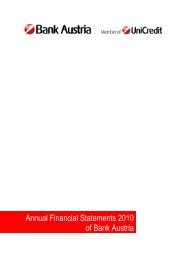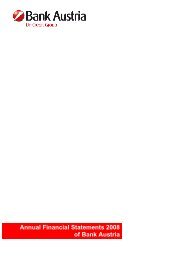Annual Financial Statements 2011 of Bank Austria
Annual Financial Statements 2011 of Bank Austria
Annual Financial Statements 2011 of Bank Austria
You also want an ePaper? Increase the reach of your titles
YUMPU automatically turns print PDFs into web optimized ePapers that Google loves.
Consolidated <strong>Financial</strong> <strong>Statements</strong> in accordance with IFRSs<br />
A – Accounting policies (CoNTINuED)<br />
The annual impairment test <strong>of</strong> goodwill, as required by IAS 36, is carried out as at the end <strong>of</strong> each reporting period. In addition, impairment tests are<br />
performed again whenever there is an indication that goodwill may be impaired.<br />
The carrying amount <strong>of</strong> a cash-generating unit is determined on the basis <strong>of</strong> pro-rata equity and the carrying amount <strong>of</strong> goodwill allocated to that unit.<br />
The recoverable amount relating to each CGU is the value in use and is determined on the basis <strong>of</strong> future cash flows expected from each CGU to<br />
which goodwill has been allocated.<br />
The following valuation calculations are based on the 2012 budget and the current five-year plan. According to current information available to the<br />
Management Board <strong>of</strong> <strong>Bank</strong> <strong>Austria</strong>, the 2012 budget and the assumptions for the years 2013 to 2021 are in line with probable developments at the<br />
respective business units (cash-generating units). Given the imponderable nature <strong>of</strong> future economic trends, actual developments may also differ from,<br />
and be significantly worse than, these assumptions.<br />
For the fair value calculation the Standard UniCredit Group Discounted Cash Flow Valuation Model (3-phase model) was employed throughout the<br />
Group using the following assumptions:<br />
• Phase 1 (<strong>2011</strong>): the figures are based on year-end projections for net pr<strong>of</strong>it and risk-weighted assets <strong>of</strong> the respective cash-generating units.<br />
• Phase 2 (2012–2021)<br />
– Phase 2a – planning period (2012–2015): the 2012 budget figures for net pr<strong>of</strong>it and RWAs were used for 2012, and multi-year planning figures<br />
were used for subsequent years.<br />
– Phase 2b (2016–2021): in this phase the growth rates <strong>of</strong> net income and risk-weighted assets converge towards 2%. The discount rate in the<br />
form <strong>of</strong> cost <strong>of</strong> equity (Ke) declines to the corresponding terminal value level (for details see page 86).<br />
• Phase 3 – perpetual annuity: calculation <strong>of</strong> the present value <strong>of</strong> a perpetual annuity on the assumption <strong>of</strong> a long-term growth rate which takes the<br />
sustained long-term economic growth expected by <strong>Bank</strong> <strong>Austria</strong> for the euro area into account (2%).<br />
Phase 2a is the result <strong>of</strong> a detailed planning process which does not exceed the 5-year horizon in accordance with IAS 36. The purpose <strong>of</strong> phase 2b is<br />
to illustrate the expected long-term convergence <strong>of</strong> growth rates in these markets to those in Europe.<br />
<strong>Bank</strong> <strong>Austria</strong> · <strong>Annual</strong> <strong>Financial</strong> <strong>Statements</strong> <strong>2011</strong><br />
85
















